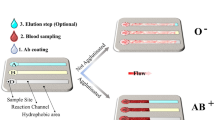Abstract
The most widely known blood groups, ABO and RhD, have been extensively observed as having strong antibody-antigen interactions during blood typing. However, not all interactions show the same binding affinity. The Duffy blood group system, where Fya and Fyb antigens are the most clinically significant, are only available with an IgG antibody structure, and display weak binding interactions. While current blood typing techniques are well established, methods for quantifying the binding strength are more limited. Surface Plasmon Resonance (SPR) provides avenues for developing more robust detection methods, and serve as a sensitive quantification technique by itself. This study tested SPR for the detection of weaker antibody-antigen interactions using the Duffy blood groups, Fya and Fyb, as a model. This study shows a minimum threshold of antibody concentration is required for successful detection. Some instances of detection were successful using concentrated commercial anti-Fya and anti-Fyb solution during the incubation stage. However, these results were not fully reproducible. We found that a significant dissociation of the Duffy antigen-antibody complex occurs over time. A combination of factors affects the detection of the Duffy antigens using SPR; these include antibody concentration, antigen expression, and antigen structure. This results in weak, unstable and reversible antibody-antigen interactions which are currently limiting accurate and reproducible detection by SPR. Despite these issues, detection of Duffy antigens Fya and Fyb was demonstrated using SPR; however, further development is required for SPR to become a robust clinical blood typing technique.






Similar content being viewed by others
References
B. Armstrong, Antigen–antibody reactions. ISBT Sci. Ser. 3(2), 21–32 (2008)
M. Beseničar, P. Maček, J. H. Lakey, G. Anderluh, Surface plasmon resonance in protein–membrane interactions. Chem. Phys. Lipids 141(1–2), 169–178 (2006)
V. Chabot, C. M. Cuerrier, E. Escher, V. Aimez, M. Grandbois, P. G. Charette, Biosensing based on surface plasmon resonance and living cells. Biosens. Bioelectron. 24(6), 1667–1673 (2009)
G. Daniels, Human blood groups, (John Wiley & Sons, 2008)
G. Daniels, I. Bromilow, Essential guide to blood groups (Hoboken, Wiley-Blackwell, 2007)
G. Daniels, M. Contreras, S. Allard, Red cell Immunohaematology. Postgraduate Haematology (Wiley, Oxford, 2015)
L. G. Fägerstam, Å. Frostell-Karlsson, R. Karlsson, B. Persson, I. Rönnberg, Biospecific interaction analysis using surface plasmon resonance detection applied to kinetic, binding site and concentration analysis. J. Chromatogr. A 597(1–2), 397–410 (1992)
P. Gomes, D. Andreu, Direct kinetic assay of interactions between small peptides and immobilized antibodies using a surface plasmon resonance biosensor. J. Immunol. Methods 259(1–2), 217–230 (2002)
R. J. Green, R. A. Frazier, K. M. Shakesheff, M. C. Davies, C. J. Roberts, S. J. B. Tendler, Surface plasmon resonance analysis of dynamic biological interactions with biomaterials. Biomaterials 21(18), 1823–1835 (2000)
R. Gutiérrez-Gallego, J. Bosch, G. Such-Sanmartín, J. Segura, Surface plasmon resonance immuno assays – a perspective. Growth Hormon. IGF Res. 19(4), 388–398 (2009)
D. M. Harmening, Modern blood banking and transfusion practices (F.A. Davis, Philadelphia, 1999)
P. D. Issitt, D. J. Anstee, Applied blood group serology (Montogomery Scientific Publications, Durham, 1998)
S. Kimura, K. Yurugi, H. Segawa, J. Kuroda, K. Sato, M. Nogawa, T. Yuasa, H. Egawa, K. Tanaka, T. Maekawa, Rapid quantitation of immunoglobulin G antibodies specific for blood group antigens a and B by surface plasmon resonance. Transfusion 45(1), 56–62 (2005)
O. Krupin, C. Wang, P. Berini, Selective capture of human red blood cells based on blood group using long-range surface plasmon waveguides. Biosens. Bioelectron. 53, 117–122 (2014)
B. Liedberg, C. Nylander, I. Lundström, Biosensing with surface plasmon resonance — how it all started. Biosens. Bioelectron. 10(8), i-ix (1995)
M. Malmqvist, Surface plasmon resonance for detection and measurement of antibody-antigen affinity and kinetics. Curr. Opin. Immunol. 5(2), 282–286 (1993)
J. M. McDonnell, Surface plasmon resonance: towards an understanding of the mechanisms of biological molecular recognition. Curr. Opin. Chem. Biol. 5(5), 572–577 (2001)
W. M. Mullett, E. P. C. Lai, J. M. Yeung, Surface Plasmon resonance-based immunoassays. Methods 22(1), 77–91 (2000)
D. G. Myszka, Kinetic analysis of macromolecular interactions using surface plasmon resonance biosensors. Curr. Opin. Biotechnol. 8(1), 50–57 (1997)
M. Otamiri, K. G. I. Nilsson, Analysis of human serum antibody–carbohydrate interaction using biosensor based on surface plasmon resonance. Int. J. Biol. Macromol. 26(4), 263–268 (1999)
J. G. Quinn, R. O'Kennedy, M. Smyth, J. Moulds, T. Frame, Detection of blood group antigens utilising immobilised antibodies and surface plasmon resonance. J. Immunol. Methods 206(1–2), 87–96 (1997)
J. G. Quinn, S. O'Neill, A. Doyle, C. McAtamney, D. Diamond, B. D. MacCraith, R. O'Kennedy, Development and application of surface Plasmon resonance-based biosensors for the detection of cell–ligand interactions. Anal. Biochem. 281(2), 135–143 (2000)
R. Reverberi, L. Reverberi, Factors affecting the antigen-antibody reaction. Blood Transfus. 5(4), 227–240 (2007)
P. Schuck, Reliable determination of binding affinity and kinetics using surface plasmon resonance biosensors. Curr. Opin. Biotechnol. 8(4), 498–502 (1997)
D. R. Shankaran, K. V. Gobi, N. Miura, Recent advancements in surface plasmon resonance immunosensors for detection of small molecules of biomedical, food and environmental interest. Sensors Actuators B Chem. 121(1), 158–177 (2007)
V. Silin, A. Plant, Biotechnological applications of surface plasmon resonance. Trends Biotechnol. 15(9), 353–359 (1997)
I. Stojanović, R. B. M. Schasfoort, L. W. M. M. Terstappen, Analysis of cell surface antigens by surface Plasmon resonance imaging. Biosens. Bioelectron. 52(0), 36–43 (2014)
W. L. Then, M.-I. Aguilar, G. Garnier, Quantitative blood group typing using surface plasmon resonance. Biosens. Bioelectron. 73, 79–84 (2015)
K. Yurugi, S. Kimura, E. Ashihara, H. Tsuji, A. Kawata, Y. Kamitsuji, R. Hishida, M. Takegawa, H. Egawa, T. Maekawa, Rapid and accurate measurement of anti-a/B IgG antibody in ABO-unmatched living donor liver transplantation by surface plasmon resonance. Transfus. Med. 17(2), 97–106 (2007)
Acknowledgments
Funding provided by the Australian Research Council and Haemokinesis (LP110200973) is gratefully acknowledged. Many thanks to the Australian Red Cross Blood Service (ARCBS), Melbourne, Victoria for blood samples.
Author information
Authors and Affiliations
Corresponding author
Rights and permissions
About this article
Cite this article
Then, W.L., McLiesh, H., Aguilar, MI. et al. Duffy blood group (Fya & Fyb) analysis using surface plasmon resonance. Biomed Microdevices 18, 101 (2016). https://doi.org/10.1007/s10544-016-0123-6
Published:
DOI: https://doi.org/10.1007/s10544-016-0123-6




